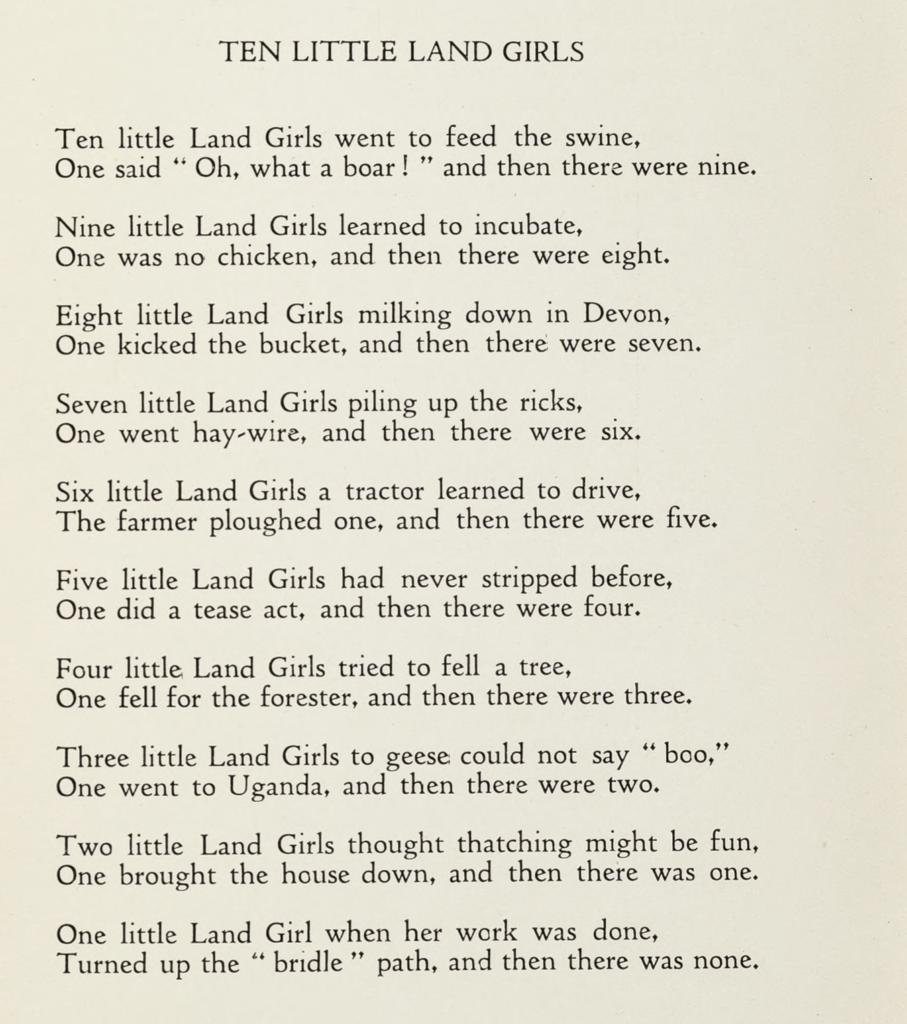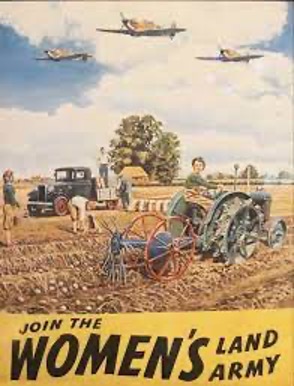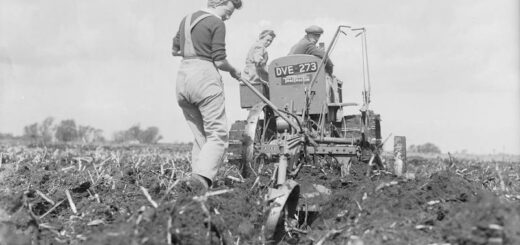Ten Little Land Girls: ambiguity and subversion in WLA poetry
Today I’m delighted to publish the second in a new series of monthly blogs, written by Geraldine Roberts-Stone. As part of her PhD research, Geraldine examined some of the poems penned by Land Girls during the Second World War. You can read Geraldine’s first post in the series here.
In this poem, Jean Moncrieff adopts a style rich in puns and ambiguity. Beneath the comic tone, a close reading shows there are multiple potential layers of meaning.

Challenges to traditional female roles abound from the offset, as a land girl shirks from her duty of providing food “oh, what a boar.” In 1944, the Royal Commission on Population was concerned with a decline in the birth rate. Therefore, women were encouraged to reproduce, with nursery care offered as a carrot (Riley in Higonnet et al, 1987, p.263).

However, the second girl is not compliant. Despite learning to incubate she is, ultimately, “no chicken.” Additionally, land girls kick the milk bucket and bring “the house down.” Can these actions be read as further rejection of motherhood and domesticity?

As the final land girl “turns up the ‘bridle’ path,” this means that “then there were none.” If the horse’s “bridle” can be read as a pun on the “bridal” path, here marriage results in the disappearance of the woman and the loss of her identity. Many accounts from serving WLA members in the Second World War highlight the sense of pride, freedom and independence which their work afforded.

Additionally, working away from home gave some land girls the opportunity to explore sexuality, including taboo lesbian desire. Free sexuality is depicted through the land girls who strip and do a “tease act” and fall for “the forester,” behaviour at odds with the requirement for women to be demure. As Jenny Hartley (1997, p.65) observes: “men fight and their women support them; women’s sexual loyalty was equated with the sacrifices men were making at the front, and advocated as a patriotic contribution to the morale of the nation’s forces.”

However, as if these activities were not disruptive enough to the British state, one girl takes matters further. Sonya Rose (2003, p.76) has discussed wartime concerns regarding the perceived threat posed by black American GIs stationed in Britain, tempting white women on the “road to ruin.”
Previously unable to say “boo” to geese, by going to “Uganda,” she embodies the fear of interracial sexual relationships.
Alongside using humour and rural imagery from the working day to challenge prescribed wartime roles for women, Moncrieff uses these devices for social comment, whilst hinting at darker undercurrents in a land girl’s life.

The sending of the girl up the “bridle”/bridal path once her “work was done” also echoes a change in focus in Allied propaganda from 1944. Having called women to work to support the war effort, they were called back home via the images of neglected children missing their mothers (Honey, 1984, p.211).

Meanwhile, if the girl’s “kicking the bucket” is read as a metaphor for death, there are hints of the very physical dangers of the land girl’s life in contrast to the rural idyll portrayed in recruitment posters.

However, the fate of one land girl is the most disturbing. Whilst learning to drive a tractor, she is “ploughed” by the farmer. Here are undercurrents of the sexual abuse and rape which some land girls found themselves subjected to whilst living in isolated, male-dominated agricultural communities.
Despite the Ministry of Agriculture appointing reps and inspectors to oversee the welfare of land girls, this pastoral support often failed to materialise (Mant, 1994, introduction). As Secretary of the WLA Benevolent Fund, Moncrieff may have been familiar with such cases.
While a first reading of this poem might read as nothing more than a comical take on work as a Land Girl, a deeper, more sensitive reading reveals the range of pressures which Land Girls faced in their new wartime occupations.
Bibliography
Hartley, J (1997) Millions Like Us: British Women’s Fiction of the Second World War London: Virago
Honey, M (1984) Creating Rosie the Riveter: Class, Gender and Propaganda During World War Two Massachusetts: University of Massachusetts Press
Mant, J (1994) All Muck and No Medals: Landgirls by Landgirls Sussex: Book Guild
Riley, D ‘Some Peculiarities of Social Policy Concerning Women in Wartime and Postwar Britain’ in Higonnet, M et al (eds.) (1987) Between the Lines: Gender and the Two World Wars New Haven: Yale University Press
Rose, S (2003) Which People’s War? National Identity and Citizenship in Wartime Britain 1939-45 Oxford: Oxford University Press




